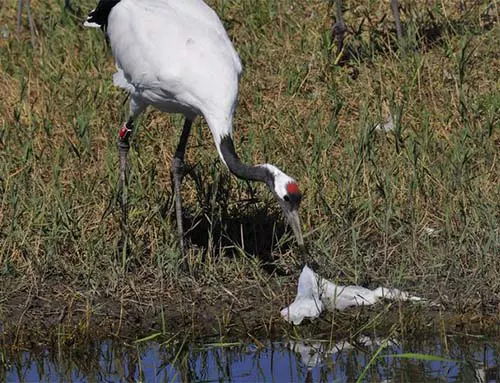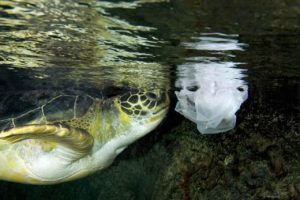What Animals Are Hurt Most by Single-Use Plastic Bags?

Going Reusable Will Save Our Wildlife
Disposable plastic shopping bags have a serious environmental impact especially as far as wildlife is concerned. Litter in general is a problem and single use plastic shopping bags pose a major risk because they do not completely break down. The thin film disposable plastic bags are constructed from, makes them lightweight enough that they can easily be moved by a gentle breeze or a water current but because they are plastic, they can withstand the elements and stick around basically forever. Between damage caused to habitats and to animals themselves single-use plastic bags are a severe problem.
Plastic Debris is a Significant Problem in Water
Our oceans are full of discarded plastic garbage, but lakes, streams, rivers and even ponds accumulate plastic trash, too. Marine animals are at risk when plastic litter floats in water since they may mistake a disposable plastic bag as prey and consume it. Once eaten the thin film of single-use plastic bags can obstruct the animal’s digestive system, leading to a slow and painful death. Animals can also become stuck in plastic bags, and this can limit the animal’s mobility and possible prevent them from being able to defend themselves, making them an easy target for predators.
The Impact of Disposable Plastic Bags on Birds
About 44 percent of seabird species worldwide are impacted by litter – either by becoming entangled or through ingestion. Numerous studies have found plastic particles in seabird’s stomachs, and what makes this even more alarming is that most birds regurgitate food into the mouths of their young, so small pieces of plastic can be passed on.
Studies Have Shown Whales Are at Risk from Exposure to Plastic Trash

There have been numerous incidents of whales consuming large amounts of litter that results in severe harm or death. In 2008, two sperm whales found off the California coast had large amounts of debris, including fishing nets and plastics in their digestive tracks – one of these whales had eaten a staggering 450 pounds of litter. In 2002, a dead minke whale was discovered on the Normandy coast of France had nearly a ton of plastic in its stomach, including single-use plastic shopping bags.
How Single-Use Plastic Bags Harm Sea Turtles
Studies have found that 50 percent of all sea turtles consume plastic. Other studies have shown that location does not appear to be a factor in exposure or likelihood to consume plastic litter. Water carries trash, so a plastic bag that enters the water can travel and end up thousands of miles from where it started, meaning that all sea turtles are at risk.
These examples are just a sampling of the devastation – research and random discoveries have turned up many, many instances of animals in distress or carcasses filled with plastic litter. It is also worth noting that there is a big unknown concerning just how many animals are impacted since it is very likely there are significantly more animals that fall victim to plastic litter, but their bodies are never discovered.
What Can You Do?
Birds, whales and sea turtles are not the only animals who suffer the consequences of plastic litter, but these animals are widely impacted. What makes this problem so alarming is the amount of litter carelessly discarded, and that this problem continues to spiral out of control. The easiest solution is to be responsible concerning the use of plastic – switch to more durable and reusable products whenever possible and when you do use plastic make sure to disposable of it properly.
Tagged





I hate this! Seeing that picture of the beautiful sandhill crane pecking at plastic makes me think twice before going plastic. It’s amazing, I moved to a new city and they use so much more plastic and styrofoam here. It really depends on which city you’re in!
Hi Lindsay! I certainly hear you. Over at LinkedIn today there was actually someone who said that we have “moved beyond” the reusable bag conversation which I found to be surprising. Thank you for your supportive comment and for stopping by. – Shane
Pingback: Why Are Reusable Bags Better than Single Use Plastic Bags? Here's Your Answer